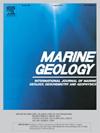波罗的海南部的铁结核:形态、矿物学和地球化学
IF 2.2
3区 地球科学
Q2 GEOSCIENCES, MULTIDISCIPLINARY
引用次数: 0
摘要
对包括波罗的海在内的海洋和陆架海的多金属结核的研究有着悠久的历史。然而,波兰南部波罗的海地区结核的详细矿物学和地球化学数据与波罗的海海洋和其他地区的数据相比是有限的。这项研究填补了关于波罗的海南部结核的矿物学和化学成分的知识空白。该研究涉及波兰专属经济区(EEZ)的两个地点的结核样本,即Słupsk Furrow和Gdańsk盆地(P1)之间的海底高度以及Bornholm盆地和Słupsk Furrow (P2)之间的海底高度,这些地区以其丰富的结核而闻名。采用x射线衍射(XRD)、扫描电子显微镜(SEM-EDS)、电感耦合等离子体发射光谱/光学发射光谱(ICP-MS/OES)和电子探针微量分析(EPMA)等分析方法。结核由陆源矿物和本地锰氧化物混合而成,代表为碧玉矿、vernadite(7个Å和10个Å品种)和氧化铁,主要是针铁矿。根据地点的不同,样品显示出不同的化学成分。P1取样点结核的特征是中等铁含量,平均为10.68 wt%,低锰含量,平均为3.04 wt%, Mn/Fe比值为0.12 ~ 0.43。这些结核含有低浓度的∑Ni + Co + Cu (104.5 ~ 238.6 ppm)和其他经济上重要的金属,如Zn (78.0 ~ 140 ppm)、Mo (14.9 ~ 77.8 ppm)和V (80.0 ~ 187.0 ppm)。这些结核表现出明显的锂富集,浓度从72.1到444.6 ppm不等。另一方面,采样点P2的平均参数较高,Fe含量为12.30 wt%, Mn含量为10.50 wt%, Mn/Fe比值为0.50 ~ 1.25。∑Ni + Co + Cu的浓度变化范围为159.0 ~ 530.0 ppm, Zn (104.0 ~ 238.0 ppm)、Mo (26.0 ~ 174.0 ppm)和V (118.0 ~ 249.0 ppm)含量升高。锂含量低(最大。145.4 ppm)。P1田区生长速率为2.21 ~ 3.47 mm/1000年,P2田区生长速率为6.50 ~ 21.00 mm/1000年。结核的成因可能受热液活动的影响,表明成岩-氢成混合作用。虽然波罗的海没有发生经典的热液过程,但深层流体的影响可能会显著地影响结核的形成。本文章由计算机程序翻译,如有差异,请以英文原文为准。
Fe-nodules from the southern Baltic Sea: Morphology, mineralogy and geochemistry
Studies of polymetallic nodules in oceans and shelf seas, including the Baltic Sea, have a long history. However, detailed mineralogical and geochemical data for nodules from the southern Polish Baltic region are limited in comparison to data from oceans and other regions of the Baltic Sea. This study fills gaps in knowledge regarding the mineralogical and chemical composition of nodules from the southern Baltic. The research concerned nodules sampled from two locations in the Polish Exclusive Economic Zone (EEZ), namely seabed elevations between the Słupsk Furrow and Gdańsk Basin (P1) and between Bornholm Basin and Słupsk Furrow (P2), areas known for their abundance of nodules. The following analytical methods were used: X-ray diffraction (XRD), scanning electron microscopy (SEM-EDS), inductively coupled plasma emission spectroscopy/optical emission spectroscopy (ICP-MS/OES) and electron probe microanalysis (EPMA). The nodules comprise a mixture of terrigenous minerals and autochthonous manganese oxides, represented by birnessite, vernadite (7 Å and 10 Å varieties) and iron oxyhydroxides, mainly goethite. Depending on the location, the samples reveal varying chemical compositions. Nodules from sampling site P1 are characterized by a moderate Fe content, averaging 10.68 wt%, and low Mn content, averaging 3.04 wt%, with an Mn/Fe ratio ranging from 0.12 to 0.43. These nodules have low concentrations of ∑Ni + Co + Cu (104.5 to 238.6 ppm) and other economically significant metals such as Zn (78.0–140 ppm), Mo (14.9–77.8 ppm), and V (80.0–187.0 ppm). These nodules exhibit pronounced lithium enrichment, with concentrations ranging from 72.1 to 444.6 ppm. On the other hand, at sampling site P2, the average parameters are higher, i.e., Fe content 12.30 wt%, Mn 10.50 wt%, and a Mn/Fe ratio of 0.50 to 1.25. The concentration of ∑Ni + Co + Cu ranges from 159.0 to 530.0 ppm, with elevated contents of Zn (104.0–238.0 ppm), Mo (26.0–174.0 ppm), and V (118.0–249.0 ppm). Lithium content is low (max. 145.4 ppm). In field P1, the growth rates ranged from 2.21 to 3.47 mm/1000 years, while in field P2, the growth rates ranged from 6.50 to 21.00 mm/1000 years. The genesis of the nodules indicates mixed diagenetic‑hydrogenetic processes probably influenced by hydrothermal activity. Although classical hydrothermal processes do not occur in the Baltic Sea, the impact of deep-seated fluids may significantly shape the formation of the nodules.
求助全文
通过发布文献求助,成功后即可免费获取论文全文。
去求助
来源期刊

Marine Geology
地学-地球科学综合
CiteScore
6.10
自引率
6.90%
发文量
175
审稿时长
21.9 weeks
期刊介绍:
Marine Geology is the premier international journal on marine geological processes in the broadest sense. We seek papers that are comprehensive, interdisciplinary and synthetic that will be lasting contributions to the field. Although most papers are based on regional studies, they must demonstrate new findings of international significance. We accept papers on subjects as diverse as seafloor hydrothermal systems, beach dynamics, early diagenesis, microbiological studies in sediments, palaeoclimate studies and geophysical studies of the seabed. We encourage papers that address emerging new fields, for example the influence of anthropogenic processes on coastal/marine geology and coastal/marine geoarchaeology. We insist that the papers are concerned with the marine realm and that they deal with geology: with rocks, sediments, and physical and chemical processes affecting them. Papers should address scientific hypotheses: highly descriptive data compilations or papers that deal only with marine management and risk assessment should be submitted to other journals. Papers on laboratory or modelling studies must demonstrate direct relevance to marine processes or deposits. The primary criteria for acceptance of papers is that the science is of high quality, novel, significant, and of broad international interest.
 求助内容:
求助内容: 应助结果提醒方式:
应助结果提醒方式:


